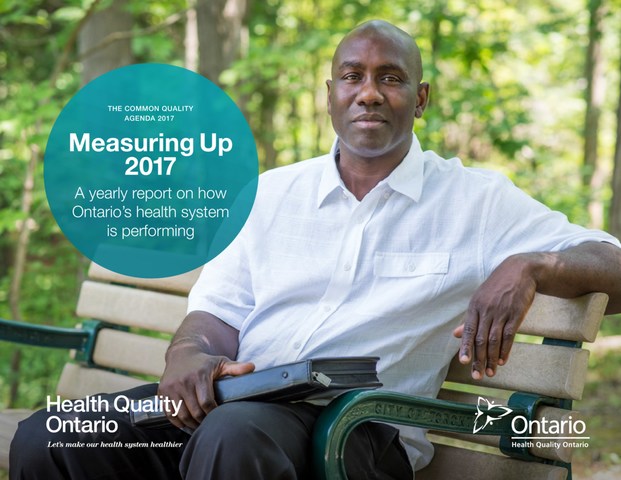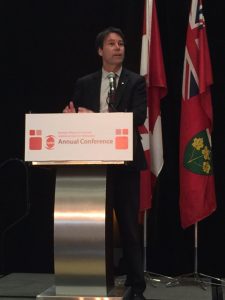A hard look at Ontario's health system
TORONTO, Oct. 23, 2017 /CNW/ - Measuring Up 2017 – Health Quality Ontario's 11th yearly report on the health of Ontarians and how the health system is performing – shows that people in the province are living longer and are losing fewer years of their lives to premature death.

The report contains other positive findings that show many parts of Ontario's health system are working well or better than before:
- More patients are receiving cancer surgery within maximum wait time targets.
- More people are getting high-priority MRI and CT diagnostic scans within maximum wait time targets.
- Care for residents in long-term care homes is improving.
- More people are being screened for colorectal cancer.
- People are receiving primary care consistently from the same doctor.
However, Measuring Up 2017 also shows Ontario's health system still faces significant challenges, such as people having to wait too long for certain forms of care, not getting the care they need as they transition between parts of the system, or not having equitable access to care. The report identifies several areas where improvements in access, transitions and equity are needed:
- More hospitals beds are occupied by patients waiting for care elsewhere.
- Patients are experiencing longer delays when they need to be moved from the emergency department to an inpatient hospital bed.
- People with a mental illness or addiction continue to face difficulties in accessing mental health care.
- People who live in certain regions or have lower incomes sometimes have poorer access to health care.
- Informal caregivers of home care patients are increasingly distressed.
- Fewer patients are having surgery within target wait times for hip and knee replacements.
Compared to other provinces and countries, Ontario's performance is mixed. Ontario has the lowest rate of premature mortality of any province in Canada, and performs best or second-best in key aspects of long-term care. However, compared to 10 socioeconomically similar countries, Ontario ranks last in access to primary care appointments on the same day or next day when patients are sick, and in the middle of the pack when it comes to patients' ability to pay medical expenses not covered through private or provincial insurance plans.
"This year's Measuring Up report shows that the work done in Ontario to improve health system performance in key areas such as wait times for cancer patients and resident care in long-term care homes has clearly brought positive results," says Joshua Tepper, president and CEO of Health Quality Ontario. "The report also shows many challenges remain that need to be the focus of ongoing efforts to provide the best health care for all Ontarians."
Measuring Up 2017 also includes stories detailing the personal experiences of patients, caregivers and health care providers to illustrate the real-life impact of the health system on real people.
Quick facts
Findings in areas that are doing well or improving
- The rate of potential years of life lost (in deaths before age 75) improved by 17.6% in Ontario between 2003 and 2013, to 4,221 years per 100,000 people, from 5,120. Ontario has the lowest rate of potential years of life lost among Canadian provinces.
- The proportion of cancer surgeries completed within provincial maximum wait time targets increased overall between 2008/09 and 2016/17. Depending on the priority level of the surgery, the number of cancer patients who had surgery performed within target ranged from 78% to 93%.
- Between 2012/13 and 2016/17, the proportion of patients who had their diagnostic scan completed within the provincial maximum wait time target increased to 82% from 79% for Priority 2 MRI scans, and to 96% from 92% for Priority 2 CT scans.
- The proportion of long-term care home residents without psychosis who were given antipsychotic medication fell to 22.9% from 35.0% between 2010/11 and 2015/16, while the proportion physically restrained on a daily basis declined to 6.0% from 16.1%, and the proportion who experienced moderate pain daily or any severe pain fell to 6.1% from 11.9%.
- The proportion of Ontarians overdue for colorectal cancer screening decreased to 38.7% in 2015 from 43.6% in 2011.
- Among Ontarians who had at least three primary care visits to a physician within the previous two years, 57.3% had high continuity of care from the same doctor, 27.4% had medium continuity, and 15.2% had low continuity, in 2015/16.
Findings in areas that need improvement
- An average of 3,961 Ontario hospital beds per day were occupied by patients waiting to receive care elsewhere in 2015/16. Those 3,961 beds were the equivalent of 10 large hospitals.
- For patients who were admitted to hospital, the average length of stay in emergency increased 10.9% to 15.2 hours in 2016/17 from 13.7 hours in 2015/16.
- Between 2006 and 2015, about a third of people who went to the emergency department for a mental health condition had not received mental health care from a primary care doctor or psychiatrist over the previous two years.
- The rate of potential years of life lost was nearly 2.5 times higher in the area of the province with the highest rate – the North West Local Health Integration Network (LHIN) region – at 7,647 years per 100,000 people, than in the region with the lowest rate – the Central LHIN region – at 3,026 years per 100,000 population, during the 2010-2012 period.
- Among urban residents, those who lived in the lowest-income neighbourhoods had the highest rate of being overdue for colorectal cancer screening in 2015, at 46.5%, while those who lived in the highest-income neighbourhoods had the lowest rate of being overdue, at 32.7%.
- In the first half of 2016/17, among long-stay home care patients with at least one informal caregiver, 24.3% had caregivers who experienced continued distress, anger or depression in relation to their caregiving role, compared to 21.2% in the first half of 2012/13. That was a 14.6% increase over a four-year period.
- In 2016/17, the proportion of patients who had Priority 4 knee replacement surgery within the wait target fell to 80% from 85%, so that 1 in 5 had to wait longer than the maximum wait target of six months. Priority 4 is the category of knee replacement with the greatest number of surgeries.
To read the full report visit: www.hqontario.ca/MeasuringUp2017
About Measuring Up
Measuring Up 2017 is Health Quality Ontario's 11th yearly report to Ontarians on health system performance. Its findings are based on data from a set of about 50 health system indicators, called the Common Quality Agenda, developed in association with health care experts and health system partners such as doctors, nurses, hospitals, local health integration networks and home care providers, as well as patients and their families and caregivers. This year's report highlights findings from 28 indicators.
About Health Quality Ontario
Health Quality Ontario is the provincial advisor on the quality of health care. With the goal of excellent care for all Ontarians, Health Quality Ontario reports to the public on how the system is performing, develops standards for what quality care looks like, evaluates the effectiveness of new health care technologies and services, and promotes quality improvement aimed at sustainable positive change. Visit www.hqontario.ca for more information.
SOURCE Health Quality Ontario




